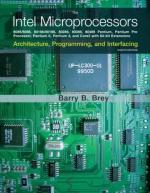|
This section contains 341 words (approx. 2 pages at 300 words per page) |
In 1969, after the integrated circuit had become widely available, a Japanese calculator company, Busicom, approached Robert Noyce 's newly formed Intel Corporation. Busicom wanted Intel to produce a set of 12 interconnected integrated circuits for a new line of desktop electronic calculators. Noyce gave the project to Marcian "Ted" Hoff Jr., an Intel research and development engineer.
Hoff found the Busicom plan far too complex, linking it to a growing problem in the microchip industry: A different set of logic chips was needed for each individual product, making design and production of items that used integrated circuits slow, difficult, and expensive. Hoff thought of a way to solve this problem. He designed a general-purpose logic chip, one that incorporated all the logic circuitry of a computer's central processing unit (CPU). Called a microprocessor, this universal CPU chip could be combined with a separate chip for a program written for a specific device. Along with two other chips, for memory and data, the microprocessor plus program chip was a complete general-purpose computer.
After Busicom contracted with Intel to produce the microprocessor, Federico Faggin produced the detailed chip layout and circuit design. In exchange for a price reduction, Busicom gave Intel the right to market the chip. Intel put this first microprocessor, the 4004, on sale late in 1971, calling it a " computer on a chip." About the size of a pencil point, the 4004 was more powerful than the original room-sized electronic computer of 1948, ENIAC. The 8008, with double the 4004's capacity, followed the next year, superseded in 1974 by the much more powerful and efficient 8080. Other manufacturers soon came out with their own microprocessors.
Sales of the microprocessor were slow at first, until engineers realized its vast potential. It made the microcomputer possible, taking the computer out of huge government and university centers and spreading it to legions of individual users across the country. Microprocessors became pervasive elements of everyday life, controlling the operations of such familiar items as cars, microwave ovens, washing machines and clothes dryers, thermostats, wristwatches, cash registers, telephones, and gas pumps.
|
This section contains 341 words (approx. 2 pages at 300 words per page) |


